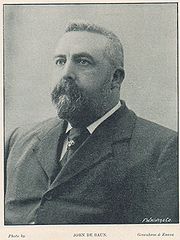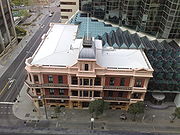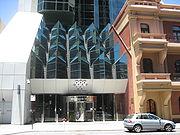
Palace Hotel, Perth
Encyclopedia

Perth, Western Australia
Perth is the capital and largest city of the Australian state of Western Australia and the fourth most populous city in Australia. The Perth metropolitan area has an estimated population of almost 1,700,000....
is a landmark three-storey heritage listed building located in the city's central business district
Central business district
A central business district is the commercial and often geographic heart of a city. In North America this part of a city is commonly referred to as "downtown" or "city center"...
. Originally built in 1897 as a hotel during the gold rush
Gold rush
A gold rush is a period of feverish migration of workers to an area that has had a dramatic discovery of gold. Major gold rushes took place in the 19th century in Australia, Brazil, Canada, South Africa, and the United States, while smaller gold rushes took place elsewhere.In the 19th and early...
period of Western Australia's history, it was converted to banking chambers and offices in the 1980s and now accommodates offices and banking chambers of the Bank of Western Australia Ltd. (BankWest). The building is located on the most prominent intersection in the financial district of the city, at the corner of St Georges Terrace and William Street
William Street, Perth
William Street is a suburban distributor and one of two major cross-streets in Perth, Western Australia.Commencing in western Mount Lawley it also crosses the Perth to Fremantle railway at the Horseshoe Bridge....
and sits in the shadow of one of the tallest buildings in Perth, the 204 metres (669.3 ft) BankWest Tower
BankWest Tower
The BankWest Tower is a 52-storey office tower in Perth, Western Australia. Completed in 1988, the building measures to its roof and to the tip of its communications antenna. It was the tallest building in Perth from its completion in 1988 until 1992 when it was overtaken in height by Central...
.
When the hotel opened for business on 18 March 1897 it was, although slightly smaller than some of its contemporary buildings in other capital cities in Australasia, described as "... one of the most beautiful and elegant hotels in Australasia". Other praise included: "... redolent of the bourgeois luxury and splendour of the Paris of Napoleon III" and later "... in its day, as sumptuous a hostelry as any in Melbourne or Sydney." It operated as licensed premises from 1897 until 1981.
Style and heritage features
The building is described as being of a 'Federation Free ClassicalFederation architecture
Federation architecture refers to the architectural style in Australia, which was prevalent from around 1890 to 1920. The period refers to the Federation of Australia on 1 January 1901, when the Australian colonies collectively became the Commonwealth of Australia...
' architectural style. It is three storeys high and of brick and iron construction. It was designed by architects Porter and Thomas and built by prominent mining entrepreneur and real-estate investor John De Baun at a cost of £64,000.
In 1973, a public lobby group known as The Palace Guards was formed to push state planning authorities for the preservation of the building. The building was entered into the register of the National Trust of Australia
National Trust of Australia
The Australian Council of National Trusts is the peak body for community-based, non-government organisations committed to promoting and conserving Australia's indigenous, natural and historic heritage....
in June 1973 and elevated to a permanent entry in 1980 "as a first-class example of the quality of building at the time of the gold rush".
In the period leading up to and during the 1980s redevelopment, lobbying from The Palace Guards, the National Trust of Western Australia and the public at large pushed for the retention of some elements of the original building. In 1990, legislation enforcing compliance with heritage preservation orders was enacted and the site became the subject of the first heritage agreement in the State. It was recorded as a permanent entry in the state heritage register at the Heritage Council of Western Australia
Heritage Council of Western Australia
The Heritage Council of Western Australia is the Government of Western Australia agency created to identify, conserve and promote places of cultural heritage significance in the state.It was created under the Heritage of Western Australia Act...
in May 2000.
Cultural significance
Due to its ornate and grand style, its prominent position within the city, and being the only building of its type and scale in St Georges Terrace, the hotel has been an important landmark in Perth for all of its life. In its early years, the hotel afforded commercial travellers a high level of opulence and comfort while visiting the city and offered a tangible reminder of the wealth and prosperity of the state during the gold-boom period.Prior to the construction of the Perth Town Hall
Perth Town Hall
The Perth Town Hall, situated on the corner of Hay and Barrack streets, is the only convict-built town hall in Australia.Designed by Richard Roach Jewell and James Manning in the Victorian Free Gothic style, the hall was built by convicts and free men between 1868 and 1870...
in 1870, the site (which then housed the Freemasons' Hotel) was the pre-eminent social and political focus of the town—important decisions such as the establishment of a local police force in 1851 were made there. At the time of its transformation into banking chambers in the 1980s, considerable amounts of nostalgia and acclamation of its place in Perth were reflected in the local media.
History

BankWest Tower
The BankWest Tower is a 52-storey office tower in Perth, Western Australia. Completed in 1988, the building measures to its roof and to the tip of its communications antenna. It was the tallest building in Perth from its completion in 1988 until 1992 when it was overtaken in height by Central...
which adjoins the Palace Hotel is named the 'William Leeder Entrance' in honour of the proprietor of the first hotel on the site. The Perth Gazette wrote in August 1833:
Few, if any, of [the employed classes] enjoyed a table such as the gentry made merry with at Leeder's Hotel on the occasion of the King’s birthday celebrations in August 1833, with nine types of meat and a choice of three desserts.
Leeder's Hotel was extended in 1845, by which time it was known as the Freemasons' Tavern and housed the first Masonic Lodge
Masonic Lodge
This article is about the Masonic term for a membership group. For buildings named Masonic Lodge, see Masonic Lodge A Masonic Lodge, often termed a Private Lodge or Constituent Lodge, is the basic organisation of Freemasonry...
in Western Australia. Following the death of Leeder in 1848, his wife transferred the management to Julian Carr
Julian Carr (Australian politician)
Julian George Charles Carr was a Member of the Western Australian Legislative Council from 1868 to 1873.The son of William Carr, gentleman, Julian Carr was born in England around 1824. Nothing is known of his early life, but on 11 May 1846 he married Katherine Agnes Francisco, a cousin of Sir...
, a merchant who would later become a prominent local politician and Chairman of the Perth City Council from 1861 until 1869. At this time it was known as the Freemasons' Hotel with a number of other proprietors running it in the intervening years, including the wife of future Premier
Premier of Western Australia
The Premier of Western Australia is the head of the executive government in the Australian State of Western Australia. The Premier has similar functions in Western Australia to those performed by the Prime Minister of Australia at the national level, subject to the different Constitutions...
Sir Walter James
Walter James
Sir Walter Hartwell James KCMG KC was the fifth Premier of Western Australia and an ardent supporter of the federation movement....
and George Towton, a prominent horseman and hotelier.
A fire at the rear of the hotel in 1888 destroyed a number of outbuildings, adding to the premises' general dilapidation. American real estate investor and former hotelier John De Baun purchased the property from Leeder's widow for ₤14,000 in 1894, along with several other sites along St Georges Terrace. He engaged architects Ernest Saunders Porter and Edmond Neville Thomas to design the new Palace HotelThere were numerous Palace hotels in Australia in that period. In Western Australia alone they were to be found at Sandstone
Sandstone, Western Australia
Sandstone is a small town located in the Mid West region of Western Australia. The town is located 157 kilometres east of Mount Magnet and 661 kilometres north of the state capital, Perth...
, Kalgoorlie
Kalgoorlie, Western Australia
Kalgoorlie, known as Kalgoorlie-Boulder, is a town in the Goldfields-Esperance region of Western Australia, and is located east-northeast of state capital Perth at the end of the Great Eastern Highway...
, Peak Hill (Meekatharra
Meekatharra, Western Australia
Meekatharra is a town in the Mid West region of Western Australia. Meekatharra is an Australian Aboriginal word meaning 'place of little water'. At the 2006 census, Meekatharra had a population of 798, with 44.0% being Aboriginal....
), Wagin
Wagin, Western Australia
Wagin is a town and shire in the Great Southern region of Western Australia, approximately 225 km south-east of Perth on the Great Southern Highway between Narrogin and Katanning. It is also on State Route 107. The main industries are wheat and sheep farming.-History:The name of the town is...
, Walkaway
Walkaway, Western Australia
Walkaway is a small town in the City of Greater Geraldton local government area of Western Australia. At the 2006 census, Walkaway had a population of 262....
, Laverton, Southern Cross
Southern Cross, Western Australia
Southern Cross is a town in Western Australia, 371 kilometres east of Perth on the Great Eastern Highway. It was founded by gold prospectors in 1888, and gazetted in 1890. It is the major town and administrative centre of the Shire of Yilgarn...
and York
York, Western Australia
York is the oldest inland town in Western Australia, situated 97 km east of Perth in the Avon Valley near Northam, and is the seat of the Shire of York...
. Several still exist. for the site with no expense to be spared and many of the construction materials imported. Marble for the fireplaces and mosaic floor tiles for the main entrance and bar-room floors came from Italy. It boasted having "electric light and gas laid on in every room", as well as electric bells and speaking tubes "conveniently placed everywhere" and was reputed to have the first lift in Perth as well as 10 bathrooms serving the 50 bedrooms on the first floor. De Baun also commenced construction of the nearby Melbourne Hotel in 1895 in similar style, if not quite the same degree of opulence and grandiosity.
James Thomas Glowrey leased the Palace Hotel from De Baun in 1901 and carried out the first of many additions and modifications to the building, including the addition of bedroom wings on the north and east wings. A newspaper advertisement dated 1903 boasted:
...the hotel as the finest hotel in the State, with 130 bedrooms, a number of suites of private apartments, a writing room and library, fine dining hall, a grand vestibule, electric light and electric elevator and large sample rooms.
De Baun died in 1911 and ownership passed to the West Australian Trustee Executor and Agency Company Limited while Glowrey's lease was maintained. Charles Atkins (of Atkins Brothers Pty Ltd) purchased the property in 1924 for £48,000, keeping Glowrey on as the lessee. A younger relative, James Henry Glowrey took over the lease in 1930 and major internal renovations costing £15,000 were undertaken at the same time, including enlarging the bar areas and conversion of the basement billiard room to a new bar area. External renovations were made in 1935 and 1939. In 1959 a major modernisation project commenced costing £160,000 and included installation of air conditioning, private bathrooms, and the replacement of timber verandas with cantilevered concrete verandas. Prior to this refurbishment, engraved lettering of the former name De Baun's Palace Hotel was displayed in the corbelling above the front entrance.
1980s redevelopment


J.M. Freeland, professor of architecture at the University of New South Wales
University of New South Wales
The University of New South Wales , is a research-focused university based in Kensington, a suburb in Sydney, New South Wales, Australia...
wrote at the time:
This is a most important building for the history of Australian architecture, being an extreme example of High Victorian architecture. There were never many hotels of its standard in Australia and to my knowledge this is the last of them.
The campaign opposing the demolition culminated in a condemnation of the plan from the National Estates Committee and an appeal from the bank for the Australian Government
Government of Australia
The Commonwealth of Australia is a federal constitutional monarchy under a parliamentary democracy. The Commonwealth of Australia was formed in 1901 as a result of an agreement among six self-governing British colonies, which became the six states...
to acquire the property. Bond Corporation
Alan Bond (businessman)
Alan Bond is an Australian businessman noted for his criminal convictions and high-profile business dealings, including what was at the time the biggest corporate collapse in Australian history. Bond was born in the Hammersmith district of London, England, and emigrated to Australia with his...
ultimately purchased the property and the adjacent Terrace Arcade in 1978 and in 1980 unveiled plans (which had been pre-approved by the Perth City Council) for a modern office block and the demolition of parts of the existing building and adjoining properties. The developers had successfully sought modification of the original planning approval by the Council to allow the use of the Palace Hotel as a bank, rather than remaining as a public hotel. The development plans were summarised in the Trust News, the journal of the National Trust of Australia as:
The erection of a multi-storied, multi-use tower block on the North East corner of the site; retention of the Palace Hotel structure on the South West corner; development of a covered concourse between the two structures linking William Street with St George’s Terrace. This will require: demolition of the structure housing the Terrace Arcade; demolition of the eastern accommodation wing of the hotel; dismantling and reconstruction of the northernmost portion of the William Street façade; [and] dismantling and reconstruction of the dining-room.
The tower project and restoration of the hotel were carried out as a joint venture between Bond Corporation and the R&I Bank, with the first demolition tasks commencing in August 1981. The hotel closed in June 1986 amid demolition works and construction—by August 1983 construction had completed on the tower's foundation and three levels of underground parking. The project was completed in 1988 and officially opened in August 1989 by premier Peter Dowding
Peter Dowding
Peter McCallum Dowding SC was the 24th Premier of Western Australia, serving from 25 February 1988 until his resignation on 12 February 1990 after an internal party dispute....
.
The redevelopment entailed demolition of much of the interior wallspaces of the old hotel, however, the exterior façades facing the two main streets are largely intact, if slightly shortened on the William street frontage. A glass covered atrium joins the tower on the former hotel so that the tower entrances double as undercover access to the building.

